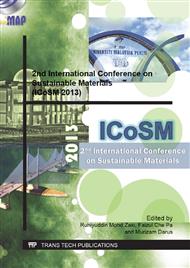[1]
C.W. Tang, S.A. VanSlyke, Organic electroluminescent diodes, Appl. Phys. Lett. 51 (1987) 913-5.
DOI: 10.1063/1.98799
Google Scholar
[2]
S-J. Kim, Y. Zhang, C. Zuniga, S. Barlow, S.R. Marder, B. Kippelen, Efficient green OLED devices with an emissive layer comprised of phosphor-doped carbazole/bis-oxadiazole side-chain polymer blends, Org. Electron. 12 (2011) 492-6.
DOI: 10.1016/j.orgel.2010.12.006
Google Scholar
[3]
C.C. Yap, M. Yahaya, M.M. Salleh, Influence of tetrabutylammonium hexafluorophosphate (TBAPF6) doping level on the performance of organic light emitting diodes based on PVK:PBD blend films, Curr. Appl. Phys. 9 (2009) 722-6.
DOI: 10.1016/j.cap.2008.06.013
Google Scholar
[4]
P. Camurlu, U. Giovanella, A. Bolognesi, C. Botta, G. Cik, Z. Végh, Polythiophene-polyoxyethylene copolymer in polyfluorene-based polymer blends for light-emitting devices, Synth. Met. 159 (2009) 41-4.
DOI: 10.1016/j.synthmet.2008.07.018
Google Scholar
[5]
R.F. Cossiello, A. Cirpan, F.E. Karasz, L. Akcelrud, T.D.Z. Atvars. Electroluminescence of (styrene-co-acrylic acid) ionomer/conjugated MEH-PPV blends, Synth. Met. 158 (2008) 219-25.
DOI: 10.1016/j.synthmet.2008.01.011
Google Scholar
[6]
R. Reyes, M. Cremona, E.E.S. Teotonio, H.F. Brito, O.L. Malta, Voltage color tunable OLED with (Sm,Eu)-β-diketonate complex blend, Chem. Phys. Lett. 396 (2004) 54-8.
DOI: 10.1016/j.cplett.2004.07.074
Google Scholar
[7]
M. Valadares, I. Silvestre, H.D.R. Calado, B.R.A. Neves, P.S.S. Guimarães, L.A. Cury, BEHP-PPV and P3HT blends for light emitting devices, Mater. Sci. Eng. C. 29 (2009) 571-4.
DOI: 10.1016/j.msec.2008.10.006
Google Scholar
[8]
C.C. Yap, M. Yahaya, M.M. Salleh, Influence of thickness of functional layer on performance of organic salt-doped OLED with ITO/PVK:PBD:TBAPF6/Al structure, Curr. Appl. Phys. 8 (2008) 637-44.
DOI: 10.1016/j.cap.2007.11.006
Google Scholar
[9]
W.J. Lee, Y.K. Fang, H-C. Chiang, S.F. Ting, S.F. Chen, W.R. Chang, et al. Improving turn on voltage and driving voltage of organic electroluminescent devices with nitrogen doped electron transporter. Solid State Electron. 47 (2003) 927-9.
DOI: 10.1016/s0038-1101(02)00393-3
Google Scholar
[10]
G. Xie, Y. Meng, F. Wu, C. Tao, D. Zhang, M. Liu, et al. Very low turn-on voltage and high brightness tris-(8-hydroxyquinoline) aluminum-based organic light-emitting diodes with a MoOx p-doping layer, Appl. Phys. Lett. 92 (2008) 093305-3.
DOI: 10.1063/1.3046542
Google Scholar
[11]
H. Nie, B. Zhang, X.Z. Tang. Significant improvement of OLED efficiency and stability by doping both HTL and ETL with different dopant in heterojunction of polymer/small-molecules. Chinese Phys. 16 (2007) 730-4.
DOI: 10.1088/1009-1963/16/3/028
Google Scholar
[12]
P-C. Kao, J-H. Lin, J-Y. Wang, C-H. Yang, S-H. Chen. Li2CO3 as an n-type dopant on Alq3-based organic light emitting devices. J. Appl. Phys. 109 (2011) 094505-6.
Google Scholar
[13]
N. Chopra, J. Lee, Y. Zheng, S-H. Eom, J. Xue, F. So, High efficiency blue phosphorescent organic light-emitting device, Appl. Phys. Lett. 93 (2008) 143307-3.
DOI: 10.1063/1.3000382
Google Scholar
[14]
S. Xu, M. Yang, S. Cao, A fluorescent copolyimide containing perylene, fluorene and oxadiazole units in the main chain, React. Funct. Polym. 66 (2006) 471-8.
DOI: 10.1016/j.reactfunctpolym.2005.10.008
Google Scholar
[15]
M. Neghabi, A. Behjat, Electrical and electroluminescence properties of ITO/PEDOT:PSS/TPD:Alq3:C60/Al organic light emitting diodes, Curr. Appl. Phys. 12 (2012) 597-601.
DOI: 10.1016/j.cap.2011.09.010
Google Scholar
[16]
J. Manca, W. Bijnens, R. Kiebooms, J. D'Haen, M. D'Olieslaeger, T.D. Wu, et al. Effect of oxygen on the electrical characteristics of PPV-LEDs, Opt. Mater. 9 (1998) 134-7.
Google Scholar
[17]
Y.K. Fang, Y.T Chiang, S.F. Chen, C.Y. Lin, S.C. Hou, C.S. Hung, et al. Observation of room temperature negative differential resistance (NDR) in organic light-emitting diode with inorganic dopant, J. Phys. Chem. Solids. 69 (2008) 738-41.
DOI: 10.1016/j.jpcs.2007.07.067
Google Scholar


